It seems that Scotland captured our hearts and imagination, so much so we found it difficult to leave. The planned two weeks have stretched into seven, and now its time to move on but let me tell you about the last few places we enjoyed before returning to English soil.
Continuing down the West coast we arrived at Ayr, the weather was so hot we couldn’t resist having a day at the beach like everyone else. A very long, lovely sandy wide beach with miles of shallow water ideal for little ones. Not great for parking motor homes strangely. For us it was a day off from everything, we sunbathed, ate ice creams and read books as if we were on holiday!
Over the past couple of weeks, there have been less arty places, less impromptu parking places and the site we stayed at in Ayr was business-like. We were missing the Highlands.
Next stop Girvan, a great wild parking spot on the seafront overlooking a huge mound in the sea called Ailsa Craig (meaning Fairy Rock). It’s also known as Paddy’s milestone as it’s just a hop over from Belfast Ireland, to Glasgow Scotland.
Ailsa Craig (land for sale…)
It is owned by the Scottish peer Archibald Angus Charles Kennedy the 8th Marquis of Ailsa and is thought by geologists to be a “plug” left behind from an extinct volcano. Made up of blue hone granite it has been quarried to make curling stones. Skipper Roddy Leitch talks of a rich history of Sea monsters; smugglers; prisoners; dragons; cannibals; folklore and legend. It even has the remains of a castle built 1400’s and an abandoned lighthouse. More recently believed to be where Winston Churchill plotted the D day landings. It is now home to seals and thousands of birds providing a sanctuary for Gannets and Puffins. Did you know, Gannets are the largest sea bird, their wingspan can reach 6.6ft!
One of the great things about the Beast is her lovely panoramic windows. Literally facing out to sea, I loved watching the weather surround this current bun shaped land, morning noon and night, each one a snap shot, I found it mesmerising. Its up for sale too, but a little too much for our pocket, Donald Trump was said to be interested, apparently the locals had an idea to club together to prevent his ownership.
Mull of Galloway (Maol nan Gall)
Mull of Galloway is Scotland’s most southerly point and an unspoilt paradise, so we took a peek. It was a drive that saw the Rhododendrons light up our journey with spectacular colours. We booked into the campsite on the beach at Drummore, we had planned to relax but a chance remark to an Artist I follow online found me secured onto a painting course at midnight for the next morning!
Robert Burns
Before we venture into a world of Julie Dumbarton’s “colourhugs”. I thought you might be interested in a little of the beloved poet, Robert Burns history. He came from these parts and is held in high esteem by the Scots. He wrote from the heart, for example, ploughing a field he destroyed a mouse nest that it needed to survive the winter, hence his poem” To a Mouse.” No doubt we have all heard of or taken part in the celebrations held worldwide on or around his birthday 25th January, Burns night? If you are thinking no, I still don’t know him, I can safely assume you have sung Auld Lang Syne at some point? That was his. He had a little success with his writing whilst alive but apparently never received the acclaim he should have. He died 1796 aged just thirty-seven, (the day his son Max was born) legend says he was born in a blizzard and wrote about how the brevity of life was there in a snowflake:
“Or the like snow falls in the river
A moment white then melts forever”
For all his love of life and gregarious nature, he was, it appears as fragile in health as a snowflake.
His wife welcomed visitors to their home which she kept as a memorial to him. The likes of Poets Samuel Taylor Coleridge and William Wordsworth visited and later John Keats 1818 and writer Nathaniel Hawthorne in 1850’s. Burns Cottage is kept as a museum now by the National Trust for Scotland, he is said to be one of the world’s best-loved poets, his words were touching and uplifting and are thought to have made the world a better place.
Julie Dumbarton fine art painter
We haven’t got up at six a.m. for some time but we rose and drove the three hours to get to Langholm in Dumfries and Galloway. It was a last-minute cancellation on a weekend course painting A Forest Pathway, Julie Dumbarton style. A quest of mine is to paint more freely and if you check out www.Juliedumbarton.co.uk you will see what I mean in her work.
Her bio reads, “artist for 20 years, lover of colour; owns a church, loves hugs” Her excited smiley hug as soon as you enter through the big old church doors she owns and uses as her studio, feels genuine and warm-hearted. Followed by tea and biscuits, surrounded by both tiny and huge canvasses bursting with colour, I was in my element, what’s not to like?
A group of sixteen, all ladies, the youngest probably mid-thirties, oldest in her seventies maybe. They came from all over the country and world, the furthest being Texas. As the weekend unfolded so did personal life stories, none more enthralling and emotional than Julies. I don’t think it’s a prerequisite to have trauma or heartache to reach into our imaginative souls but I’m sure our life events shape us and if we allow, can fine-tune us into the best and happiest person we can be, which often involves creativity of some kind.

What was Paul up to whilst I was getting paint on my clothes? Paul and one or two other partners, explored mankind’s nature, in the pub for the most part! We then all continued the celebrations into the evening by all eating/drinking together until late, ready for the smiley hug from Julie, and tea and biscuits waiting for us in the morning. The next day was a repeat, when some of us inadvertently found each other in the pub at the end of the course and so the evening of swapping our different countries stories continued with friendships forged and connections confirmed on Facebook of course. Don’t you just love it when you take a chance and go with the flow of what life presents to you.
Sixteen paintings all of the same image taught at the same time but all different; individual and unique. That’s one of the things I love about art, allowing yourself the freedom, you can only be you. So, thank you to Julie for the tuition which I’m sure will inform my personal style. Thanks to Craig for the endless tea and lovely lunch and the colourful mix of ladies who made my weekend so special. Not forgetting Paul whose encouragement to fulfil my dreams is something money can’t buy.
By the way, we stayed at a basic site next to the rugby club Langholm, £13. Per night and the best water pressure in the showers we have come across, great result.
Kirkcudbright (pronounced Kir-coo-bree)
In our three-hour dash to Julies lovely old art studio church and my weekend of enlightenment, we passed a town many had recommended to us. Kirkcudbright, known as the Artist Town. So, we doubled back for a couple of days and found it to be a place where beauty creativity and community spirit reigns. We learnt that everyone in the town raised money and donated £2 each because they decided the town needed a swimming pool, now the council have joined in and help support it. Despite the town brimming with Artists of all genres, the community thought they should have a proper art gallery and with the same determination now have that too. The money we paid for the site we stayed in on the top of a hill overlooking the town, all went to local sports for the town’s children. Many of the shops are family run or collaborations and one pub, in particular, The Selkirk Arms, has played a key role in the town’s history dating back to 1777 and still does to this day. Poet Robert Burns was said to have lodged there on several occasions and it is said he even penned the Selkirk Grace there. A busy events calendar keeps the town alive and interesting whatever season you choose to visit. Doesn’t this sound like the best version a town could be?
Kippford beach
Julie recommended we stop at Kippford beach and wow how uniquely beautiful it was to see a thick carpet of cockle shells adorn the sand there.
The walk along the beach of shells is flanked by beautiful small and large cottages and holiday lets, colourfully set into the rocks and surrounded by flowers. Looking up at huge windows framing a circular lounge on top of the rocks we saw that ten people could let that property…hmmm an easy choice for us, who else is coming?
The Royal Yacht Britannia
We had regretted not visiting The Royal Yacht Britannia on our brief visit to Edinburgh so hot-footed it back for a quick overnight stay, wild parking along the beautiful beach there so we could visit at leisure the next day.
1997 saw the end of a tradition, the last of 83 Royal yachts that dated back to 1660. I was surprised by the homely feel, no luxury, very little pomp and ceremony visible in the furnishings and designs which the Queen and Price Phillip played a huge part of. The queen is extremely thrifty it appears, there are many examples, like not wanting to waste Queen Victoria’s ships bedding she had it fitted to size for her bedroom and the ships Wheel/helm came from an older Royal ship.
Perhaps this is why it is said she always felt so at home and relaxed when on board. Although her day still comprised of a full work schedule, she still found time to socialize and joke with those looking after her. With a band on board, there was often merriment, fun and games. Naturally, there are the other interesting facts like the Admiral would sometimes have to change twelve times a day, his outfit dependant on where they were, what time of day and who’s company he was in! Britannia was originally built to also work as a hospital ship so had a large working laundry area, which was lucky with all of those costume changes! One last interesting fact: Britannia has three masts, beneath the base of each one are hidden coins. They were placed there as payment to the angels to guard the souls of the sailors.
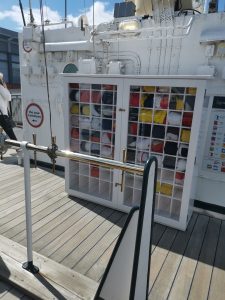
Countries Flags at the ready
Prince Phillip’s Easel and carefully concealed bar behind a painting!
Scotland’s Coal Mining Museum
We drove back via the scenic route of the A7 stopping off to visit Scotland’s Coal Mining Museum
We stayed in its car park overnight so we had a whole day there as the tour and displays take up quite some time. We had a personal tour by a retired miner Jim, which was so interesting as was the history of mining when children as young as 5 or 6 were given the boring job of sitting in the dark dirty mine with nothing to do other than opening and closing a door when needed. By the way, because of the way the distribution of air and gasses work if they didn’t close the door, they could kill everyone down there!
We, of course, tried the local (only) pub, The Dean, that has always played a huge role in the town and is now a community run pub. The miners used to collect their wages from the pub and the wives would also be in a line waiting for the housekeeping, not silly, are we!
Leaving Scotland, we headed into Cumbria from which we have fond very old memories of holidays with friends when the children were small. The Beatrix Potter museum and rolling hills where we experienced all weathers in one day. Nothing has changed, still great for kids and adults wherever you explore. We found ourselves parked wild the first night and searching for a site as we knew we were almost at the Beast limits, but literally all of them we booked. Travelling means we lose track of the calendar and of course being half term, we should have pre-booked somewhere. We visited Cockermouth town first then found a pub that allows motor homes to overnight park, even though there was no hook up etc, finding a place to wild camp is harder here so we got to know Terry and Nicola the helpful owners of The Posting House (can recommend mushroom stroganoff) stayed a couple of nights and swapped tales with a couple from the Netherlands as they were doing our trip the other way around!
Cockermouth is Poet William Wordsworth’s birth town.
You find yourself avoiding saying Cockermouth! But it simply derives from the river Derwent and mouth of the river Cocker meeting. Consequently, Mills grew and so did a town, Cockermouth!
A pretty area where medieval and Georgian streets nestle underneath the castle (privately owned and lived in) lots of independent shops and art galleries. We recommend Shills for lunch and a visit to William Wordsworth house. The bold terracotta coloured house and fine gardens stand proud on the main street just down the road from where the hangings took place in Williams day! The interesting visit included talks and a working Edwardian kitchen and recipes created by staff in typical Edwardian garb using utensils and methods of the day!. Looked after by the National Trust we very much enjoyed a walk-through history there.
.
William Wordsworth.
I was both heartened and dismayed to read about William Wordsworth life. The joy I felt when I read that in an era of strict codes of conduct, William’s father and mother afforded their children the freedom that belonged not to the 1770’s but in the 1960’s. At a time when children were seen and not heard, beaten regularly, put to work as infants and even hung in the centre of town for the smallest misdemeanours. Williams mother and father encouraged their five children’s exploration of nature and the world about them with unprecedented freedom. Playing in their garden or out amongst the rivers and forests of the Lake District, William and his sister Dorothy were able to flex their creative muscle and both started writing. Dora became an author, poet and diarist whilst William’s love was also poetry, he became a key figure of Romanticism and the author of the most famous poem ever written about daffodils. (entitled Daffodils by William Wordsworth if you do google it. It’s simple and uplifting)
William and his friend Samuel Taylor Coleridge invented a new style of poetry, in which nature and the diction of the common man surpassed their formal language of the day.
I found Wordsworth’s sentiments akin with mine and his fears then, unfortunately still so relevant today. Inspired by Wordsworth, I dared to write a poem:
With William in Mind.
Poetry is not hard to find, its right here now, as I look through the blinds. Its where the land meets the sky, especially if we view with our heart and eyes.
We will see what thousands have before, the wonder of nature right at our door.
If we stop for a while longer, eyes closed and listen,
We hear the song of the seasons; it steals into your heart and makes your eyes glisten.
In Edwardian times, the brutish realities of life, where each day was all but, toil and strive.
William Wordsworth in despair was said to have sat in a boat on a fine lake and recalled natures spirit finding him there.
As it got dark, in the quiet,
where he could hear as he did in the womb.
Mother nature spirits spoke to him there, and boom,
he recognised her anger, looked at the damage of mankind.
He felt there will be a penance for us being so blind.
Poetry connects to our inner voice, to give us the council to give us choice,
to give us the courage to truly be, to right the wrongs, to change history.
Ordinary, with will and passion.
Typical, with eyes that see.
Customary, with ears that listen.
Regular, like you and me.
Our voices can sing, shout or debate, to weave back into natures poetry, it’s not too late.
For hope is eternal, without it we would die,
but perish we must if we don’t have nature by our side.
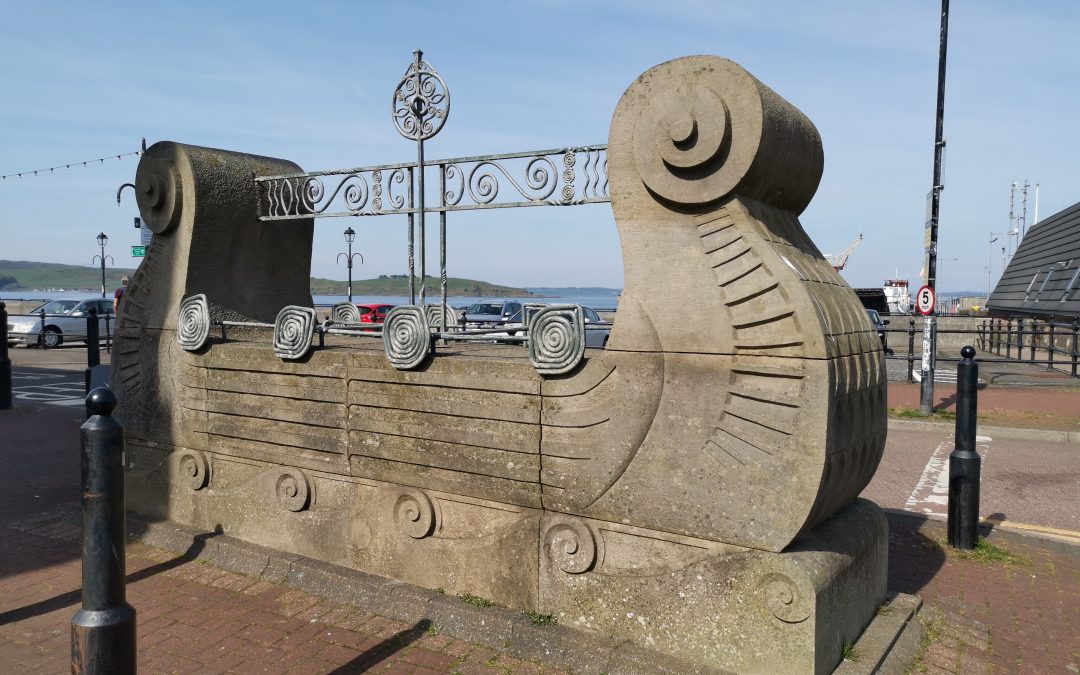






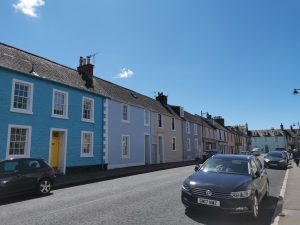


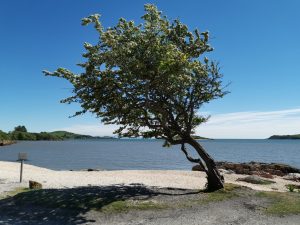




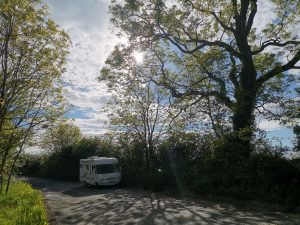


Well done! I enjoyed hearing of your travels and have made a list of places to visit when we return. Your poetry is quite nice. I, too, feel a close relationship with nature and the song of the ages. But you put it into words! Good luck to your daughter. I look forward to to keeping in touch with you and Paul. BTW… Howard and I are “in” for a stay at the beach cottage!
Hey Lynda, thank you for your comments. We could actually make the beach cottage a painting retreat? There are two pubs for the boys, haha. If we tell Julie we have wine she may well visit too! glad we are connected xx
That all sounds brill. I regularly visited Kippford. It was a lovely sunny place. Hope your travels go well….after the arrival of the baby. We are away in Hope Valley , Derbyshire for the weekend. Pouring with rain when we arrived so parked up our motorhome and headed out to the village and the dog dragged us into the local pub!
Great to see you blog, thanks, Wendy
Haha they know best and so devoted to their owners needs! Hope it brightens up for you, happy travelling.